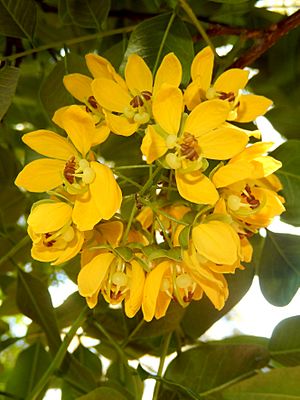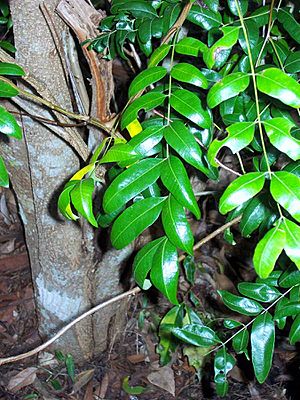Marks cassia facts for kids
Quick facts for kids Marks Cassia |
|
|---|---|
 |
|
 |
|
| Conservation status | |
| Scientific classification | |
| Kingdom: | |
| (unranked): | |
| (unranked): | |
| (unranked): | |
| Order: | |
| Family: | |
| Genus: |
Cassia
|
| Species: |
C. marksiana
|
| Binomial name | |
| Cassia marksiana (F.M.Bailey) Domin
|
|
| Synonyms | |
The Cassia marksiana, also known as Marks cassia, is a special Australian rainforest tree. You can find it growing in the far northeastern part of New South Wales and in southeastern Queensland. People also call it cigar cassia, brush cassia, or native laburnum. Its common name, Marks cassia, honors Dr. C. F. Marks, who was an early plant collector. The Brunswick River marks the southernmost place where this tree naturally grows.
This tree lives in coastal and lowland subtropical rainforests. Sadly, most of these forests have been destroyed. Only small patches are left. Because of this, fewer than 100 Marks cassia trees are known to exist in the wild. They are spread across about 20 different locations. This makes the Marks cassia an endangered plant, meaning it's at high risk of disappearing forever.
What Marks Cassia Looks Like
The Marks cassia is a small to medium-sized tree. It can grow up to 25 meters (about 82 feet) tall. Its main stem, or trunk, can be as wide as 50 centimeters (about 20 inches). The trunk is usually grey-brown and has wrinkled bark. It does not have large, wide bases called buttresses.
Leaves
The leaves of the Marks cassia are special. They are called "compound leaves" and grow one after another along the stem. Each compound leaf has between four and 16 smaller leaves, called leaflets. These leaflets are usually opposite each other on the leaf stem. Each leaflet is about 2.5 to 7.5 centimeters (1 to 3 inches) long. They can be different shapes, but often look like a spearhead (lanceolate) or an egg (ovate-lanceolate). The veins on the leaves are easy to see.
Flowers and Fruits
The Marks cassia tree produces beautiful, bright yellow flowers. These flowers are very noticeable and grow in clusters called racemes. You can usually see them blooming from September to November. After the flowers, long, thin pods grow. These pods are the fruits of the tree. They can be up to 30 centimeters (about 12 inches) long and 2 centimeters (less than an inch) wide. The pods ripen between June and October.


